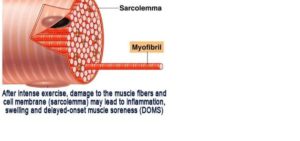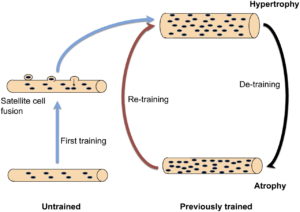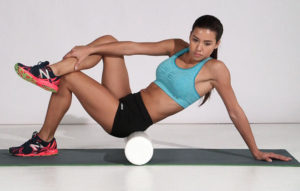If you’ve ever lifted or done any kind of exercise for that matter, then you have experienced the dreaded DOMS which stands for Delayed Onset Muscle Soreness. This is a common phenomenon experienced from novel or more intense bouts of exercise that is to be expected from your training if your starting back after a break, doing a preparatory period of higher volume or you’ve done a particularly hard session. Before we can discuss any practical terms about how you can help deal with DOMS it’s important to understand some of the mechanisms behind it so you know what you are dealing with.
“Delayed onset muscle soreness (DOMS), also called muscle fever, is the pain and stiffness felt in muscles several hours to days after unaccustomed or strenuous exercise.
The soreness is felt most strongly 24 to 72 hours after the exercise.[1][2]:63 It is thought to be caused by eccentric (lengthening) exercise, which causes microtrauma to the muscle fibers. After such exercise, the muscle adapts rapidly to prevent muscle damage, and thereby soreness, if the exercise is repeated.[1][2]:76
Delayed onset muscle soreness is one symptom of exercise-induced muscle damage. The other is acute muscle soreness, which appears during and immediately after exercise. – Wikipedia 2017
DOMS and lifting
DOMS can come from many new guises if you’re an avid runner but decide to take 2 weeks off your normal route which might be hilly in favor of a less intense route over Christmas say for y a break the first time you go back to your old more intense route your calves at the very least are going to be in agony for the next few days. It’s not just resistance training that can cause muscle damage and DOMS it’s just that one of the primary adaptation processes behind resistance training is inextricably linked to DOMS.
The micro traumas caused to the smaller myofibrils in the muscle belly is thought to be the primary signalling mechanism to allow satellite cells to bind to the damaged muscle fibre to facilitate recovery and adaptation (read hypertrophy).
The first block of a new year of training or a block designed to prime or to prepare you for a proceeding 2-3 blocks of training normally means a lot of high volume and work capacity based work. This means the primary adaptation desired from this block of training is hypertrophy or larger muscles as this allows you to better adapt from the more neural/skill based or strength-specific work you will be carrying out in the preceding few months.
As such it is a necessary if even desirable factor of life and training for you to be suffering from some level of DOMS, it’s not something you want to be experiencing a lot of in competition specific periods but for volume or preparatory phases of training (when you’re looking to prime further training) we actively want to be inducing this sensation. It isn’t 100% true that you need to be sore from training to know that you are getting the hypertrophy response you want but it is definitely something you will experience probably on a weekly basis during volume phases.
Can I get rid of or treat DOMS?
This is the part of the article where your probably wanting me to tell you here is the best way to get rid of the pain, sorry but I got bad news.
Although multiple practices exist for the treatment of DOMS, few have scientific support. Suggested treatments for DOMS are numerous and include pharmaceuticals, herbal remedies, stretching, massage, nutritional supplements, and many more. First, we briefly review eccentric exercise and its characteristics and then proceed to a scientific and systematic overview and evaluation of treatments for DOMS. We have classified treatments into 3 sections, namely, pharmacological, conventional rehabilitation approaches, and a third section that collectively evaluates multiple additional practiced treatments. The reader will note that selected treatments such as anti-inflammatory drugs and antioxi-dants appear to have a potential in the treatment of DOMS. Other conventional approaches, such as massage, ultrasound, and stretching appear less promising. – Connolly et al, 2003, Journal of Strength and Conditioning Research
So there is the possibility that some anti-inflammatory drugs such as ibuprofen can help deal with the symptoms of DOMS but this might not be desirable as has been pointed out in some ice bath or cold immersion research blunting this pain response or inflammations response might interfere with your strength and power adaptations. Which as a lifter is the last thing you want to do!
So it would appear from a treatment stand point your left with either placebo effect level intervention that will work if you believe in them or treatments that will blunt the inflammation response which in turn can reduce the adaptation response to strength or power training. In practical terms what can you do to either reduce the effect of DOMS on your function in training or to try and reduce the occurrence of them?
- Prevention is better than a cure – the best way to avoid DOMS getting too bad is to remain reasonably active during your down time. The cost to benefit ratio to this can fall in favor of complete rest depending on your age or the intensity of your previous training however for most lifters or athletes if you maintain a minimal effective dose of training volume and intensity it can be possible to reduce the severity of the DOMs you experience when you go through a volume period of training or resume normal training loads and intensity.
- The change of training is often worse than the training itself – the biggest cause of DOMS is the use of novel exercise selection or big jumps up or down in training intensity and volume. For instance, if you have ever went from doing the Westside template or maybe 5/3/1 where you squat 1-2x per week with a reasonable or moderate volume and then went into a programme like smolov or Russian squat routine and found that your legs where in absolute agony for the next 2-3 weeks it’s because you have more than tripled your training volume. This huge spike in training volumes leads to a big increase in inflammation response, muscle damage and ergo DOMs. This can also be a big factor in the incidence of injury for some lifters doing their own programming. Make sure you’re keeping your changes in training incremental and logical this will help a lot to deal with muscle soreness and protect against injury.
- There are a whole load of placebo based interventions you can use to help reduce the effect of DOMS on your training – sometimes just a good through warm-up can help to reduce the sensation in your sore muscles and get them primed for action. If your legs are hanging off a 5 minutes’ steady state spin followed by 10-15 minutes of active mobility, release work with a foam roller or lacrosse ball can really help to make stiff muscles and joints work into the session. The same thing can be done for a stiff and sore upper body. Compression can work for some people the use of items such as elbow sleeves, knee sleeves and compression tops and bottoms can really help some people reduce the pain through range due to increase muscle heat. Post training some techniques such as massage or hot baths can be used to loosen the sensation of tightness or pain. These methods however are all band-aid solutions / placebo so if they work for you and you believe in them brilliant.
- Suffer through it – DOMS are going to be a part of your training life on the very least on a 2-3x per year basis, for most lifters who follow a steady routine they will get DOMS maybe a little bit week to week but the crippling world ended DOMS come when the style of training is changed or after a big period of down time. Another common but less than effective coping stratagem is to cry to your lifting mates and use sad emoji’s in the squad group chat.
If your currently on block 1 of your strongest year I hope the DOMS aren’t too bad 🙂



